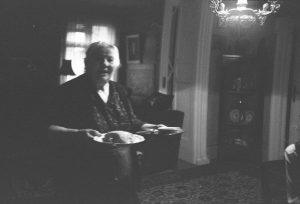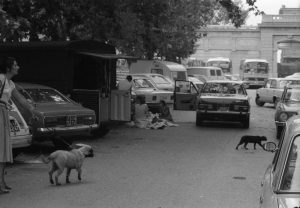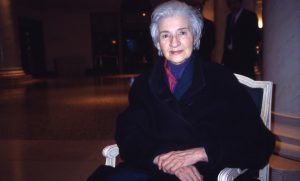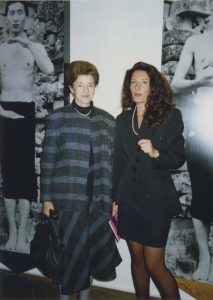Will Higginbotham talks to Marina Abramović, discussing her life and career alongside Katya Tylevich, her friend and the author of a new visual biography of the artist.
Over her five decades-long career, the Serbian performance artist Marina Abramović , has bought her medium from the niche to the mainstream. Over her career, she has confronted and challenged audiences by having a loaded gun pointed to her head, having an arrow to her heart, sitting in silence for 700 hours, and even enacting her own funeral. Her work is not touchable, it doesn’t come with a price tag, instead it is fleeting, ephemeral, and unfolds in real-time. For Marina, though, her life and art are inseparable, and that is the topic of a new biography on the artist, Marina Abramović: A Visual Biography by Katya Tylevich.
“It’s a very personal book because it is true to my life, and there are images in there I had never seen before, or forgotten about. Very few artists get something like this while they’re still alive,” Marina said, when she spoke to Port earlier this summer. The volume draws on more than 700 images and ephemera from Marina’s personal archives, weaving them into an account of her personal and artistic life. Alongside the visual are frank, amusing, and at times, heart-wrenching interviews between Marina, and Tylevich, her friend. On a recent summer day, across time zones, both sat down for an hour and shared insights into the process of putting together the book, Marina’s health troubles of the past year, and what may be next for the acclaimed artist.

Q: Thanks, both, for speaking to Port. Are you both okay if I record?
KATYA: Marina just told me there is nothing private in her life.
MARINA: Definitely. I will be insulted if you don’t record.
Q: Well, ok then. Rolling. So where do I find you both today?
MARINA: I am in New York. Two and a half hours of New York City, it is quite beautiful here, but today it looks like an English day. It’s raining, misty, grey.
KATYA: Los Angeles. In my humble abode in Venice Beach.
Q: Yeah. Beautiful. I know that place well. Over the weekend, I finished reading the book you both worked on, and it’s beautiful. Such a visual feast and celebration of life and work. It’s quite special to have a life documented so well.
MARINA: Well, that’s communism for you. We document because it can be used as evidence later on. So we collect, collect. I didn’t ever see the materials Katya was getting from my archives. There was no censorship at all. This book and what’s in it is a reflection of her choices. My life looks different reflected back to me because those were her choices. She has this kind of special taste for things, and by that I mean finding photos I would never choose in my entire life, ever, to represent me. I’d look through and say what the hell is this?
Q: I saw that in the book, actually. I think your exact words to Katya were to the effect of, why the fuck do you pick these photos?
MARINA: Yes I did. Eighty percent of the photos I have no idea where she got a particular photo from, the archives somewhere. In some I really look ugly and I would never choose an ugly photo of me. Sometimes she found ones that were so interesting to me. Like the one of a black cat crossing the road, I had no recollection of taking that, but it speaks to how deeply superstitious I am.

Q: Katya, it sounds overwhelming, just how many images did you have to work with and what are Marina’s archives like?
KATYA: There were perhaps hundreds of thousands of images to work with. She has two airplane hangars worth of archival material. So albums and old works. And then there were digital archives. I worked very closely with Marina’s office manager, Cathy , and that process had at least 23,000 images that we sifted through. From there I wanted to present Marina’s life in not just a chronological way, but also in the reoccurring themes there.
MARINA: I have 10,000 square feet of storage. I store everything. My house is mostly empty but the storage is full.
Q: You alluded to it earlier, this desire to document. Can you pinpoint a moment when you were conscious of ‘oh, I should keep this for posterity, for the future?’
MARINA: Even as a kid, I had this strange feeling of history, that everything can be historical or can become important. And my mother, as a child, even if I made a little drawing on a napkin, she’d actually keep it. So I started keeping everything too. Small little pieces of things, cuttings from newspapers. I have stationery from every hotel I’ve ever been to. I have this crazy thing with the letters I receive. I will never really open it. And then I feel so guilty. And then I know if I open it, it will be too late to answer, and I feel even more guilty. When I finally open them, it will be too late. But I collect them. And I remember that I made a work out of 100 Letters, only using the first sentence somebody wrote to me. Like ‘Dear Marina, today is Wednesday’ From that kind of first sentence, I made a book of 100 Letters, starting with my mother’s instruction notes she might leave me. Like, ‘Marina, there is a croissant on the table and eggs in the fridge’. Others were ‘Dear Marina I hear you’re painting so and so’, meaning I’m painting at that time. I found that I could trace my life just through these first sentences. At the end of 1975 when I finally left my country, it’s written, there is a letter ‘Dear Marina, we came to look for you, and you’re not there anymore.’
Q: I quite liked this idea that you wanted to relinquish control, and then have your life to date sort of reflected back at you. That’s such an act of trust. Was it hard to let someone into your archives and essentially do what they wanted with the book? Did Katya do you justice?
MARINA: I don’t think I would trust an American to do this job. It has to be somebody with a Slavic background. Katya and I have so much in common because we have a very similar childhood. Very similar restrictions in our life. Very similar humour. It helped too that when we first met years ago she reminded me of Marina Tsvetaeva, my favorite Russian poet.
Q: This book has so much humour. It’s a thread throughout the chapters, even the darker ones. I want to ask you both, how important is humour for you?
KATYA: If there’s no humour, I see no worth in pursuing it. If we only talked in the book about the emotional tragedies of life, I think that’s a lot easier than actually communicating the absurdity and the humour that comes with tragedy. That’s harder. That’s maybe something else that sets this book apart. This is by no means Marina’s first biography – Marina, I think you said that this is your sixth biography that somebody has either staged or written about.
MARINA: This is true. I think the thing that’s interesting is how this actually tells tragic stories in a funny way. Tragedy, that’s so boring. If people see something terrible on television, they shut off because they don’t want to look, yet if that same thing is made in a comic way, everybody looks.
Q: I wanted to ask, Marina, was there any particular chapter that – or maybe a certain photograph, or piece of memorabilia, that you hadn’t seen for a long time, and then you were like, oh wow, how interesting to see that here, and be reminded of a time and a place?
MARINA: It’s one of my grandmother that Katya found, and I never remember seeing it. My grandmother is coming out of the kitchen and has dishes full of food. This image made me cry because I know the smell. She’s the only one who really had time for me when I was young because my mother and father were making a political career. My mother never kissed me, it was a very cold relationship. But my grandma… I never saw this image in my life before. Katya found it.
KATYA: When we got to the photo of your mother, and she had not dyed her hair. You said to me this was the first time you saw your mother with white hair. And then you interrupted yourself, and said, I want to tell you about a different time. About when she came to the Pompidou about ten years before that photo was taken. And we kind of had a break, even in the book, to go examine that flashback. Because it’s such a painful memory to process.
MARINA: I remember that photo of my mother because I said that was when she stopped dying her hair and very shortly after, she died. It was her giving up.

Q: That was one of the best things I found reading was that this book is a celebration of life and art. The symbiotic relationship of the two. Was that a conscious choice? Or did it just sort of arise, this idea that you can’t separate Marina from her life and her art. And that’s the point.
KATYA: As soon as I visited Marina’s archives, it’s something we started to talk about. That being said, there are a lot of ways to make a book. We had to have some sort of through line to keep things cohesive.
MARINA: Books on artists are interesting because most books are just about the work, with very few images of their private life. Artists don’t usually give access to their private lives. When did you pick up a Picasso book that shared his photographs with these women on beaches or whatever – that’s rare. In this book though, it is a celebration of privacy!
Q: The chapters correlate to different periods or chapters of your life. I want to talk about the final chapter. That caught me off guard a little bit.
MARINA: For me that was the most difficult. The experience, but also wondering how do we finish the book? The last chapter speaks to something that happened to me earlier this year, I had a lung aneurysm. Two months in the hospital. Three operations. The strange thing is we almost predicted this. We had a placeholder chapter, what was it called –
KATYA: I’m not dead yet.
MARINA: I’m not dead yet. This was before it happened. So this chapter had a strange kind of feeling, that was very, very weird, for me. I couldn’t believe I actually survived. We put in a photo of me in the hospital. I didn’t put the craziest photo though, of what they took out of my lungs! Maybe saved for the next book.
KATYA: Once we knew that you were going to be okay, we managed to finish and even that chapter we had humour. You were still in the hospital and were texting me, arguing throughout. You called me from the hospital bed to talk about which friends to put into the chapter – absurdity.
MARINA: For real. I thought I was going to die, and they’re not going to be in the book! It was going to be my parting gift.
KATYA: You can’t fake chapter 12.
MARINA: One moment, I’m making a spinach pie because we have a guest for dinner tonight. I need to check it is not being burnt.
Q: I wanted to ask you, Katya, while the pie is being rescued. Would it be fair to say that part of this project was to sort of to mine a childhood and upbringing in the former Yugoslavia, and contextualize Marina’s work through that lens?
KATYA: Definitely. Marina, told me when she was in Yugoslavia, that art was actually an exit for her from the country. It was a way to escape. And then when she actually came to Amsterdam, and got a passport where she could travel freely, that was when she felt free, but she felt it necessary to impose heavier restrictions in her work at that point. So I was interested in this sense of control versus chaos. What control can you possess on your own body, and the strength of the interior world in opposition to the public surrounding you. These are all things that I think come from experiments perhaps of living in a society that tried to influence or control you. What is the possession of your soul. Is it your own or does it belong to a higher ideal? This is something that we talk at length about.
MARINA: Hmm… it’s very true what you’re saying. I also think the thing for me was that I never liked working in a studio. I wanted my ideas to come from life.

Q: On that Marina, I was familiar with your work as a performance artist, but less so about your early years as a painter. And then you describe this moment where you sort of hang that up and found your medium. Can you tell me a little about that or what that moment was like?
MARINA: It hit me that it is not necessary to go to the studio and do something two-dimensional when you can use the entire body – your body – and you can use fire, you can use water, you can use earth, you can use just use elements. And that was a huge, huge discovery. I was very, very kind of shy as a person, but I discovered that when I made my first performance as an artist, in front of the public, I possessed an energy that I didn’t know I had. My shyness disappeared immediately because I didn’t care anymore. I was naked, I was fat, I was old, I was young, I was whatever. After that, I could never go back to the studio ever again. And I knew that performance was my medium. That is a big breakthrough, for any artist.
Q: You are the one who brought performance art to this other level in terms of making the public aware of it, and you’re still going strong. How have you managed to do it for so long?
MARINA: What can I say? It is in me, but it takes unbelievable willpower every time. Discipline. That is why the Marina Abramovic Method is important, and that it must stay around because you need it with those very long performances, where it’s not one or two hours, but it’s a month or three.
Q: Marina, a slight detour here, but what are your thoughts on male artists such as Gerhard Richter and Damien Hirst. I’m interested in your thoughts on if they made interesting work.
MARINA: You know, Gerhard Richter is a really incredibly important artist. Damien Hirst is important what he’s made in history, he absolutely broke all the rules, how an artist can make his own money, which never happened before. And he also created really interesting social and political statements. But at the same time, you know, as an artist I have the parts of his work I like and big parts I don’t. But Richter is a very important artist. That’s my answer.
Q: The book coincides with a retrospective of your career in September in London at the Royal Academy. I believe it is the first time a woman’s been given that honour there. What are your thoughts on that?
MARINA: It’s quite something. The show is on the 19th of September, it has been delayed twice now. In 255 years there hasn’t been a woman in this space, so it is a big big responsibility. It’ll be open for four months. The book could not have come at a better time.
KATYA: You know that wasn’t originally the intention but there were delays both with the retrospective and the book. But when the publisher brought it to our attention we thought how about it. We had 17 months to do this book, but we really did it in about half a year.
Q: Half a year well spent I’d say. The book is really great. I could ask many other questions, but I know we’re out of time. Is there anything else you’d like to add, either of you?
MARINA: My dear, it is time I cut my pie.
KATYA: I will add this final thought though. Marina said an artist doesn’t usually get to see something like this before they die. She said that before her near-death experience.
MARINA: It is true, this is special, to see your life spread over 500 pages. Not many get that opportunity. Will there be another? (Laughing) I don’t know. Another Marina book. Well, I did just last night get sent a script for a film. Maybe I’m coming to Hollywood next (Laughter)
***
Marina Abramović: A Visual Biography by Katya Tylevich is available September 21 (UK)
Marina Abramović at the Royal Academy: 23 September 2023 – 1 January 2024




